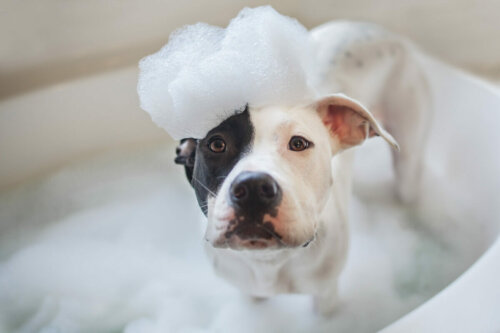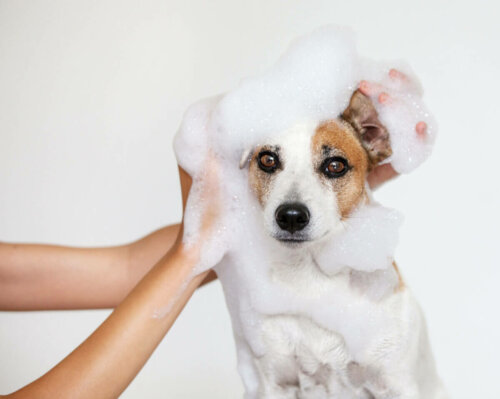Knowing When to Bathe Your Dog is Crucial

Having a pet means more than enjoying their company and having good times together. Knowing when to bathe them is also necessary – especially for their overall well-being. This implies a lot of work on a regular basis, but it’s certainly worth it.
A decent state of hygiene is essential for your canine friend, both physical and mentally. Continue reading, this article could solve any doubts you might have on the subject.
The importance of knowing when to bathe a dog
Dogs run, lie on the floor and quickly get dirty so they need grooming to be presentable. However, your pet’s needs are quite different from yours. They can’t bathe every day, for one.
This is because bathing would be counterproductive for the animal’s health. In fact, they could even die as a consequence of a cold, especially puppies. As we said above, the parameters of hygiene in our species are different from those of the rest of mammals, so keep it in mind.
As you can see, it’s essential to know when to bathe a dog, from what age, how often, with what kind of products, or simply, when you shouldn’t bathe them and should to groom them instead. Bathing your pet depends on several factors that we’ll analyze below.

Knowing when to bathe your dog according to their coat
Dog hair is the main indicator of an animal’s state of hygiene. It isn’t hard to guess and you can often tell with the naked eye. The less hair a dog has, the less you can see the dirt. However, the dirt will be quite noticeable in those with abundant and long hair, not to mention the bad smell.
As you can see, their hair can give you an idea of when it’s time to bathe a dog. So, follow these indications to know when to groom your pet:
- Short-haired breeds require bathing once every two months approximately
- Long, abundant-haired breeds need bathing once a month
- Medium-sized-haired animals should be bathed every six weeks
You can replace bathing with brushing whenever possible. Doing so will remove dirt, stimulate dead cells and distribute the fatty acids in the animal’s skin.
Knowing when to bathe a dog according to their lifestyle
Dogs’ characters also differ from one another. If yours is active and plays and lies on the floor, and rolls on the dirt, you’ll know when it needs a bath. For instance, dogs who are frequently active in open spaces, at the beach or on the hill, get dirtier than those who are less active or spend more time at home.
Be aware that soaps and shampoos could have side effects. For one, they could be too harsh and dry out their skin by diminishing the natural oils on their bodies. These aren’t only important for the shine and texture of their coat but can also protect them from dermatological diseases.
Other ways to know when to give your dog a bath
Not everything is governed by immovable rules in this life. For this reason, it’s sometimes necessary to consider whether it’s appropriate to bathe the dog or not, based on certain parameters. Some of them are:
- It’s essential to brush the dog daily to remove dirt and knots during shedding season. You can also bathe them more regularly.
- Does the animal seem overheated? A cold water bath could be a good option, especially in the summertime.
- Definitely bathe them if they’re smelly.
- A water spray will clean them up when they’ve been active.
- Canines are rather curious and sniff everything, so bathe yours immediately if they have any contact with toxic substances. You might want to consult a vet as well.
- A dirty greasy dog will be extremely uncomfortable and will need these substances off their skin in order to feel better.
Knowing when to bathe a dog
Don’t bathe them if you notice any symptoms of distemper. In this case, it’s best to take them to the veterinarian. If the specialist confirms that the dog has distemper, it shouldn’t be bathed.
This is a serious disease that, if not controlled, could kill your dog. The dog needs drugs and rest, not temperature shocks in the form of baths.
Products to bathe your pet
You need to be aware that the pH of a dog’s skin is higher than ours. For that reason, opt for a soap that maintains that natural pH and never use products made for humans. This is because they’re too acidic for them.
Myths about bathing dogs
As with everything in this life, there’s no shortage of myths in regard to bathing a dog. Here are some:
- Bathing a dog depletes the natural oils from their skin and damages their pH. This isn’t true: it can only affect their health if you wash them excessively or not at all. It can also happen if you use human soaps, as we mentioned above.
- They’ll get water in their ears and cause otitis. This isn’t a problem if you do it carefully.
- Other dogs will reject them if they smell like perfume. As you well know, dogs have a powerful sense of smell and, other animals will perceive their animal scent even if they smell good to us. This is why canine shampoos aren’t a problem.

In short, bathe your dog whenever they need it. Consult your vet for advice on the best times for their age. Your furry friend will be in good shape and enjoy a long life as long as you meet their hygiene needs. You’ll also enjoy a more pleasant living space.
Having a pet means more than enjoying their company and having good times together. Knowing when to bathe them is also necessary – especially for their overall well-being. This implies a lot of work on a regular basis, but it’s certainly worth it.
A decent state of hygiene is essential for your canine friend, both physical and mentally. Continue reading, this article could solve any doubts you might have on the subject.
The importance of knowing when to bathe a dog
Dogs run, lie on the floor and quickly get dirty so they need grooming to be presentable. However, your pet’s needs are quite different from yours. They can’t bathe every day, for one.
This is because bathing would be counterproductive for the animal’s health. In fact, they could even die as a consequence of a cold, especially puppies. As we said above, the parameters of hygiene in our species are different from those of the rest of mammals, so keep it in mind.
As you can see, it’s essential to know when to bathe a dog, from what age, how often, with what kind of products, or simply, when you shouldn’t bathe them and should to groom them instead. Bathing your pet depends on several factors that we’ll analyze below.

Knowing when to bathe your dog according to their coat
Dog hair is the main indicator of an animal’s state of hygiene. It isn’t hard to guess and you can often tell with the naked eye. The less hair a dog has, the less you can see the dirt. However, the dirt will be quite noticeable in those with abundant and long hair, not to mention the bad smell.
As you can see, their hair can give you an idea of when it’s time to bathe a dog. So, follow these indications to know when to groom your pet:
- Short-haired breeds require bathing once every two months approximately
- Long, abundant-haired breeds need bathing once a month
- Medium-sized-haired animals should be bathed every six weeks
You can replace bathing with brushing whenever possible. Doing so will remove dirt, stimulate dead cells and distribute the fatty acids in the animal’s skin.
Knowing when to bathe a dog according to their lifestyle
Dogs’ characters also differ from one another. If yours is active and plays and lies on the floor, and rolls on the dirt, you’ll know when it needs a bath. For instance, dogs who are frequently active in open spaces, at the beach or on the hill, get dirtier than those who are less active or spend more time at home.
Be aware that soaps and shampoos could have side effects. For one, they could be too harsh and dry out their skin by diminishing the natural oils on their bodies. These aren’t only important for the shine and texture of their coat but can also protect them from dermatological diseases.
Other ways to know when to give your dog a bath
Not everything is governed by immovable rules in this life. For this reason, it’s sometimes necessary to consider whether it’s appropriate to bathe the dog or not, based on certain parameters. Some of them are:
- It’s essential to brush the dog daily to remove dirt and knots during shedding season. You can also bathe them more regularly.
- Does the animal seem overheated? A cold water bath could be a good option, especially in the summertime.
- Definitely bathe them if they’re smelly.
- A water spray will clean them up when they’ve been active.
- Canines are rather curious and sniff everything, so bathe yours immediately if they have any contact with toxic substances. You might want to consult a vet as well.
- A dirty greasy dog will be extremely uncomfortable and will need these substances off their skin in order to feel better.
Knowing when to bathe a dog
Don’t bathe them if you notice any symptoms of distemper. In this case, it’s best to take them to the veterinarian. If the specialist confirms that the dog has distemper, it shouldn’t be bathed.
This is a serious disease that, if not controlled, could kill your dog. The dog needs drugs and rest, not temperature shocks in the form of baths.
Products to bathe your pet
You need to be aware that the pH of a dog’s skin is higher than ours. For that reason, opt for a soap that maintains that natural pH and never use products made for humans. This is because they’re too acidic for them.
Myths about bathing dogs
As with everything in this life, there’s no shortage of myths in regard to bathing a dog. Here are some:
- Bathing a dog depletes the natural oils from their skin and damages their pH. This isn’t true: it can only affect their health if you wash them excessively or not at all. It can also happen if you use human soaps, as we mentioned above.
- They’ll get water in their ears and cause otitis. This isn’t a problem if you do it carefully.
- Other dogs will reject them if they smell like perfume. As you well know, dogs have a powerful sense of smell and, other animals will perceive their animal scent even if they smell good to us. This is why canine shampoos aren’t a problem.

In short, bathe your dog whenever they need it. Consult your vet for advice on the best times for their age. Your furry friend will be in good shape and enjoy a long life as long as you meet their hygiene needs. You’ll also enjoy a more pleasant living space.
All cited sources were thoroughly reviewed by our team to ensure their quality, reliability, currency, and validity. The bibliography of this article was considered reliable and of academic or scientific accuracy.
- Fiechter, R., Deplazes, P., & Schnyder, M. (2012). Control of Giardia infections with ronidazole and intensive hygiene management in a dog kennel. Veterinary parasitology, 187(1-2), 93-98.
- Westgarth, C., Pinchbeck, G. L., Bradshaw, J. W., Dawson, S., Gaskell, R. M., & Christley, R. M. (2008). Dog‐human and dog‐dog interactions of 260 dog‐owning households in a community in Cheshire. Veterinary Record, 162(14), 436-442.
This text is provided for informational purposes only and does not replace consultation with a professional. If in doubt, consult your specialist.








